Air Quality in the Italian Northwestern Alps during Year 2020: Assessment of the COVID-19 «Lockdown Effect» from Multi-Technique Observations and Models
Abstract
:1. Introduction
- –
- Q1: Are changes to atmospheric composition limited to strongly polluted regions, or do they extend to remote and relatively pristine areas as well, such as the Alps?
- –
- Q2: What is the magnitude, and even the sign (due to complex and non-linear effects), of the variations of surface air pollutant concentrations in the Alps during the confinement periods? Are these effects constant throughout 2020 or do they change in the distinct phases of the control measures?
- –
- Q3: What source profiles can be identified in the Alps? Which of them actually change during the COVID-19 lockdown and which ones remain stable?
- –
- Q4: Do the estimates of the «lockdown effect» from different methods agree with each other? How accurate are the existing chemical transport models (CTMs), their emission inventories, and, notably, their modifications during the pandemic?
- –
- Q5: How large is the influence of Alpine meteorology in 2020 compared to the effect of curtailed emissions?
- –
- We focus on a mountainous region in the European Alps, the Aosta Valley (Section 2.1). In particular, we consider measurements at five stations located at short spatial distance (<70 km) in different types of environments (traffic, urban background, industrial, semi-rural, and rural).
- –
- In contrast to most of the scientific literature available until now, only covering the first half of year 2020, we analyse all-year-round measurements, and we also determine the air quality changes during the following “waves” of the pandemic.
- –
- We employ a set of different methodologies to assess the atmospheric composition changes linked to the lockdown. We do not only examine the anomalies with reference to the average concentrations from previous years, but we also integrate statistical models including weather normalisation, CTMs, and source apportionment techniques based on aerosol chemical composition, size, and optical properties. Each of these techniques has merits and limitations, which are extensively discussed in Section 3.
- –
- To support and complement the measurements at the surface, we take into consideration aerosol vertical profiles and column-integrated quantities (NO vertical column density and aerosol optical depth).
2. Data
2.1. Investigated Area and Sampling Sites
2.2. Experimental Setup
2.3. Definition of the Lockdown Phases Based on Regional and National Regulations
3. Methods
3.1. Comparison to Previous Years’ Averages
3.2. Predictive Statistical Models (Random Forest)
3.3. Chemical Transport Model
3.3.1. Emissions and Their Modifications during the Pandemic
3.3.2. Diagnostic Meteorological Model and Turbulence Pre-Processor
3.4. Aerosol Source Apportionment
3.4.1. Positive Matrix Factorisation
3.4.2. Optical Properties at the Surface
4. Results
4.1. Meteorological Context in 2020
- –
- P1 presents only few days with easterly winds, while westerly circulation is above average. The temperature in P1 during 2020 is also higher, on average, than the previous years;
- –
- P2, P3, and P4 in 2020 feature more days than average with easterly winds (indeed, 2020 holds the record of the last years in P2 and P4);
- –
- Days in P5 with persistent westerly flows are more frequent in 2020 than average, while the opposite occurs for easterly winds. The total precipitation amount is larger than average in Aosta and Donnas;
- –
- Days with westerly flows are fewer than average in P6 in 2020. Moreover, the temperature in Aosta in this period is lower than average. Thus, although precipitation is less abundant, snowfalls in Aosta are more frequent than average (about 9 days in 2020 compared to 1 day, e.g., in 2019 and 2018).
- –
- P1 is characterised by some episodes of advection of polluted air masses from the Po basin (for a total of 25 days, i.e., 37% of the time in the period). Saharan dust is also transported on seven days overall in this period.
- –
- P2 features an extraordinarily long series of transport episodes of fine particles from the Po basin (almost continuously from 14 March to 13 April, i.e., 88% of the days), according to the frequent easterly wind flows mentioned above, and mineral dust from Sahara (mainly floating at some km from the surface without settling on the ground but detected by the ALC and the sun/sky radiometer, Section 4.5). Within this period, moreover, we notice a remarkable and very unusual transport of dust particles from the area of the Caspian sea and Aral lake (e.g., [37]) between 28 and 30 March, leading to instantaneous PM concentrations g m in Aosta–downtown, with these particles being mostly concentrated in the coarse mode.
- –
- During P3, transport from the Po basin occurs for a dozen days (62%, according to the larger-than-usual frequency of easterly winds), with both fine and coarse particles involved (these latter likely still circulating from the previous long-range events).
- –
- More than 50% and about 45% of the days are affected by advection of fine and coarse aerosol from the Po basin in P4 and P5, respectively. In line with the 2020 increase in westerly winds in P5, the latter fraction is lower than average for the summer–autumn months, which, in 2020, feature a long sequence of events in September (19 days continuously) but almost no episodes in October.
- –
- Finally, in about 38% of the days in P6 the air quality in the Aosta Valley is impacted by the transport of fine particles from the Po basin, although easterly winds are too weak and intermittent to be detected by our automatic weather pattern classification, while dust is identified (but not at the surface) on 3 days only.
4.2. Changes in Surface Gaseous Pollutant Concentrations
4.3. Changes in Surface PM Concentrations
4.4. Aerosol Source Apportionment
4.5. Vertical Profiles and Column Amounts
5. Discussion and Conclusions
- -
- Q1–3: Changes in air pollutant concentrations, their magnitude, sign, and sources. At all examined stations, even the rural ones, relevant changes in air quality resulting from the confinement regulations can be identified. The largest variations occur for NO due to curtailed emissions from vehicular traffic. NO decreases by 60%–80% in March–May 2020 and by 20%–60% in November–December, depending on the site, while NO decreases slightly less, by about 40%–50% and 20%–25% in the two periods, respectively. These values agree with the results from previous studies in northern Italy and in other locations worldwide. A minor decrease at the beginning of the 2020–2021 winter season also highlights the importance of considering, as conducted here, a data set encompassing both the first and the following pandemic waves and the corresponding regulations. Among trace gases, the ozone does not show any relevant increase, contrary to what has been found in spring 2020 in more urbanised areas. Instead, O variations are modest and of different signs depending on the examined period and location and are likely affected by meteorology, e.g., Foehn winds bringing ozone-rich air masses from higher altitudes to the surface, and atmospheric exchanges with the Po basin. Particulate matter concentrations show maximum decreases of only 27% (when taking meteorology into account) due to their multifaceted nature and balance between contrasting processes. Notably, as found from the analysis of the aerosol microphysical properties (size distributions), fine particles represent a large fraction of the aerosol mass in the Aosta Valley, and they increase during the lockdown periods due to transport by intensified easterly winds (from the Po basin) in 2020 compared to the average of previous years. In particular, during the first lockdown period (P2), medium- and long-range transport contributes to the increase in PM concentrations by about 20%–30%, as determined from the chemical aerosol characterisation at the surface (secondary particles) and the retrieval of aerosol mass concentration along the vertical column with remote instruments (these latter also accounting for dust). Although not explicitly proven here, enhanced secondary aerosol production in their source area, in addition to meteorology, could contribute to the observed increase. Based on the optical source apportionment and chemical speciation, no relevant increase in biomass burning emissions from residential heating due to stay-at-home policies is observed in Aosta–downtown, although conditions in more rural areas might be different. Conversely, the mass concentration of the largest particles decreases, likely as a result of reduced resuspension by traffic, and, in Aosta, of the shutdown of the steel mill, as confirmed by the aerosol chemical speciation. The sum of the contributions from all local sources expected to decrease (traffic, soil, and industry) is consistent with the overall measured PM10 reduction.A limitation of this study is the availability of only measurements from stations located at the bottom of the valley, whereas no high-altitude station is yet available in our network to check if the air quality is influenced by the lockdown even there. As a partial integration, the analysis of the vertical column with remote sensing instrumentation shows that the aerosol profiles are mostly influenced by long-range transport, with the possible exception of a very shallow layer close to the surface, about 500 m thick, where we find negative concentration anomalies in correspondence to rush hours and mixing layer development. This aspect should be explored in more depth and in a wider context in future research. Conversely, the NO vertical column is strongly impacted by the lockdown, following similar changes as the ones found at the surface.The observed increase in atmospheric turbidity in spring 2020, compared to the previous years, is also noteworthy for another reason. Indeed, in the same period, central and southern Europe have been affected by the descent of ozone-poor air masses towards lower latitudes originating from a strong ozone column depletion over the Arctic. Simultaneously, an increase in the solar erythemal irradiance at ground by about 10% and 18% in April and May, respectively, is visible over the Aosta Valley [78]. This increase, however, is found to be too large to be solely explained by the effect of ozone. Since the atmospheric turbidity, as found here, also increases, the most likely explanation for the irradiance increase is the unusually low cloud fraction, as already demonstrated over western Europe by another study [79]. Sunshine duration measurements in the Aosta Valley, increasing up to 14% in that period compared to previous years’ average (not shown), support this hypothesis.
- -
- Q4: Agreement between observations and models. A predictive statistical model was proven to work well with NO and PM, with correlation indices generally >0.9 and >0.7, respectively. The results are useful to take the effects of weather into consideration and to decouple meteorology and emissions. The deviations between the measured concentrations in 2020 and the output of the statistical model (representing the counterfactual scenario needed for the analysis) were compared with the difference between the output of the FARM chemical transport model run with a curtailed and a standard emission scenario. For NO and PM, the comparison of the two methods provides comparable relative changes of concentrations due to the lockdown, thus confirming that both emission sources and processes are well represented by the modelling chain and that the reasons of the observed variations are well understood. For O, the effect of the lockdown resulting from the statistical predictive model and the chemical transport model even differs in sign. This could be due to meteorological phenomena not taken into account in the same way by both methods and to the influence of atmospheric dynamics acting on a wider scale, e.g., over the whole northern Italy. However, even for O, the deviations between the concentration changes assessed by the statistical and the deterministic models are generally within 10%–20%.
- -
- Q5: The influence of meteorology. The peculiar weather phenomena occurring in mountain valley regions, such as thermally driven circulation and Foehn winds, turn out to be relevant in this investigation, as well as larger-scale dynamics for aerosol transport. For example, without accounting for the increase in easterly winds, bringing secondary aerosol in the valley from March to June, the effect of the lockdown regulations on PM would have been underestimated. Indeed, the influence of the meteorology alone during the early lockdown phase in 2020, conducive to pollutant transport/accumulation, would have increased the surface concentrations by, e.g., 52%–89% (NO), 17%–18% (NO), and 8%–25% (PM and PM10) in Donnas and Aosta–downtown. Similarly, without accounting for the frequent westerly winds in summer–autumn, the effect of reduced emissions would have been overestimated. Finally, some of the observed O changes could not have been understood without a reference to meteorology.The random forest approach provides a very useful framework to quantitatively assess the relative importance of meteorological variables on air quality. Profiling instruments and retrievals of column amounts are helpful tools to identify long-range transport and to correctly interpret observations at the surface and their changes.
Supplementary Materials
Author Contributions
Funding
Data Availability Statement
Acknowledgments
Conflicts of Interest
References
- Amendola, A.; Bianchi, S.; Gori, M.; Colzani, D.; Canuti, M.; Borghi, E.; Raviglione, M.; Zuccotti, G.V.; Tanzi, E. Evidence of SARS-CoV-2 RNA in an Oropharyngeal Swab Specimen, Milan, Italy, Early December 2019. Emerg. Infect. Dis. J. 2021, 27, 648. [Google Scholar] [CrossRef] [PubMed]
- La Rosa, G.; Mancini, P.; Bonanno Ferraro, G.; Veneri, C.; Iaconelli, M.; Bonadonna, L.; Lucentini, L.; Suffredini, E. SARS-CoV-2 has been circulating in northern Italy since December 2019: Evidence from environmental monitoring. Sci. Total Environ. 2021, 750, 141711. [Google Scholar] [CrossRef]
- Gautam, S. COVID-19: Air pollution remains low as people stay at home. Air Qual. Atmos. Health 2020, 13, 853–857. [Google Scholar] [CrossRef]
- Le Quéré, C.; Jackson, R.B.; Jones, M.W.; Smith, A.J.P.; Abernethy, S.; Andrew, R.M.; De-Gol, A.J.; Willis, D.R.; Shan, Y.; Canadell, J.G.; et al. Temporary reduction in daily global CO2 emissions during the COVID-19 forced confinement. Nat. Clim. Chang. 2020, 10, 647–653. [Google Scholar] [CrossRef]
- Liu, Z.; Ciais, P.; Deng, Z.; Lei, R.; Davis, S.J.; Feng, S.; Zheng, B.; Cui, D.; Dou, X.; Zhu, B.; et al. Near-real-time monitoring of global CO2 emissions reveals the effects of the COVID-19 pandemic. Nat. Commun. 2020, 11, 5172. [Google Scholar] [CrossRef] [PubMed]
- Rodríguez-Urrego, D.; Rodríguez-Urrego, L. Air quality during the COVID-19: PM2.5 analysis in the 50 most polluted capital cities in the world. Environ. Pollut. 2020, 266, 115042. [Google Scholar] [CrossRef] [PubMed]
- Venter, Z.S.; Aunan, K.; Chowdhury, S.; Lelieveld, J. COVID-19 lockdowns cause global air pollution declines. Proc. Natl. Acad. Sci. USA 2020, 117, 18984–18990. [Google Scholar] [CrossRef]
- Zhang, Z.; Arshad, A.; Zhang, C.; Hussain, S.; Li, W. Unprecedented Temporary Reduction in Global Air Pollution Associated with COVID-19 Forced Confinement: A Continental and City Scale Analysis. Remote Sens. 2020, 12, 2420. [Google Scholar] [CrossRef]
- Barré, J.; Petetin, H.; Colette, A.; Guevara, M.; Peuch, V.H.; Rouil, L.; Engelen, R.; Inness, A.; Flemming, J.; Pérez García-Pando, C.; et al. Estimating lockdown-induced European NO2 changes using satellite and surface observations and air quality models. Atmos. Chem. Phys. 2021, 21, 7373–7394. [Google Scholar] [CrossRef]
- Bray, C.D.; Nahas, A.; Battye, W.H.; Aneja, V.P. Impact of lockdown during the COVID-19 outbreak on multi-scale air quality. Atmos. Environ. 2021, 254, 118386. [Google Scholar] [CrossRef]
- Dang, H.A.H.; Trinh, T.A. Does the COVID-19 lockdown improve global air quality? New cross-national evidence on its unintended consequences. J. Environ. Econ. Manag. 2021, 105, 102401. [Google Scholar] [CrossRef]
- Evangeliou, N.; Platt, S.M.; Eckhardt, S.; Lund Myhre, C.; Laj, P.; Alados-Arboledas, L.; Backman, J.; Brem, B.T.; Fiebig, M.; Flentje, H.; et al. Changes in black carbon emissions over Europe due to COVID-19 lockdowns. Atmos. Chem. Phys. 2021, 21, 2675–2692. [Google Scholar] [CrossRef]
- Grange, S.K.; Lee, J.D.; Drysdale, W.S.; Lewis, A.C.; Hueglin, C.; Emmenegger, L.; Carslaw, D.C. COVID-19 lockdowns highlight a risk of increasing ozone pollution in European urban areas. Atmos. Chem. Phys. 2021, 21, 4169–4185. [Google Scholar] [CrossRef]
- Guevara, M.; Jorba, O.; Soret, A.; Petetin, H.; Bowdalo, D.; Serradell, K.; Tena, C.; Denier van der Gon, H.; Kuenen, J.; Peuch, V.H.; et al. Time-resolved emission reductions for atmospheric chemistry modelling in Europe during the COVID-19 lockdowns. Atmos. Chem. Phys. 2021, 21, 773–797. [Google Scholar] [CrossRef]
- Keller, C.A.; Evans, M.J.; Knowland, K.E.; Hasenkopf, C.A.; Modekurty, S.; Lucchesi, R.A.; Oda, T.; Franca, B.B.; Mandarino, F.C.; Díaz Suárez, M.V.; et al. Global impact of COVID-19 restrictions on the surface concentrations of nitrogen dioxide and ozone. Atmos. Chem. Phys. 2021, 21, 3555–3592. [Google Scholar] [CrossRef]
- Solberg, S.; Walker, S.E.; Schneider, P.; Guerreiro, C. Quantifying the Impact of the Covid-19 Lockdown Measures on Nitrogen Dioxide Levels throughout Europe. Atmosphere 2021, 12, 131. [Google Scholar] [CrossRef]
- Piccoli, A.; Agresti, V.; Balzarini, A.; Bedogni, M.; Bonanno, R.; Collino, E.; Colzi, F.; Lacavalla, M.; Lanzani, G.; Pirovano, G.; et al. Modeling the Effect of COVID-19 Lockdown on Mobility and NO2 Concentration in the Lombardy Region. Atmosphere 2020, 11, 1319. [Google Scholar] [CrossRef]
- Collivignarelli, M.C.; Abbà, A.; Bertanza, G.; Pedrazzani, R.; Ricciardi, P.; Carnevale Miino, M. Lockdown for CoViD-2019 in Milan: What are the effects on air quality? Sci. Total Environ. 2020, 732, 139280. [Google Scholar] [CrossRef] [PubMed]
- Deserti, M.; Raffaelli, K.; Ramponi, L.; Carbonara, C.; Agostini, C.; Amorati, R.; Arvani, B.; Giovannini, G.; Maccaferri, S.; Poluzzi, V.; et al. Report COVID-19-Studio Preliminare Degli Effetti Delle Misure COVID-19 Sulle Emissioni in Atmosfera e Sulla Qualità Dell’aria nel Bacino Padano-Giugno 2020. Technical Report, prepAIR Project. 2020. Available online: https://www.lifeprepair.eu/wp-content/uploads/2020/06/COVIDQA-Prepair-19Giugno2020_final.pdf (accessed on 4 August 2021).
- Deserti, M.; Raffaelli, K.; Ramponi, L.; Carbonara, C.; Agostini, C.; Amorati, R.; Arvani, B.; Giovannini, G.; Maccaferri, S.; Poluzzi, V.; et al. Report 2 COVID-19-Studio Preliminare Degli Effetti Delle Misure COVID-19 Sulle Emissioni in Atmosfera e Sulla Qualità Dell’aria nel Bacino Padano-Agosto 2020. Technical Report, prepAIR Project. 2020. Available online: https://www.lifeprepair.eu/wp-content/uploads/2020/09/Sintesi_rapporto_2_QA_Lockdown_Aug2020_no_rev.pdf (accessed on 4 August 2021).
- Rossi, R.; Ceccato, R.; Gastaldi, M. Effect of Road Traffic on Air Pollution. Experimental Evidence from COVID-19 Lockdown. Sustainability 2020, 12, 8984. [Google Scholar] [CrossRef]
- Sicard, P.; De Marco, A.; Agathokleous, E.; Feng, Z.; Xu, X.; Paoletti, E.; Rodriguez, J.J.D.; Calatayud, V. Amplified ozone pollution in cities during the COVID-19 lockdown. Sci. Total Environ. 2020, 735, 139542. [Google Scholar] [CrossRef]
- Lonati, G.; Riva, F. Regional Scale Impact of the COVID-19 Lockdown on Air Quality: Gaseous Pollutants in the Po Valley, Northern Italy. Atmosphere 2021, 12, 264. [Google Scholar] [CrossRef]
- Granella, F.; Reis, L.A.; Bosetti, V.; Tavoni, M. COVID-19 lockdown only partially alleviates health impacts of air pollution in Northern Italy. Environ. Res. Lett. 2021, 16, 035012. [Google Scholar] [CrossRef]
- Cameletti, M. The Effect of Corona Virus Lockdown on Air Pollution: Evidence from the City of Brescia in Lombardia Region (Italy). Atmos. Environ. 2020, 239, 117794. [Google Scholar] [CrossRef] [PubMed]
- Putaud, J.P.; Pozzoli, L.; Pisoni, E.; Martins Dos Santos, S.; Lagler, F.; Lanzani, G.; Dal Santo, U.; Colette, A. Impacts of the COVID-19 lockdown on air pollution at regional and urban background sites in northern Italy. Atmos. Chem. Phys. 2021, 21, 7597–7609. [Google Scholar] [CrossRef]
- Altuwayjiri, A.; Soleimanian, E.; Moroni, S.; Palomba, P.; Borgini, A.; De Marco, C.; Ruprecht, A.A.; Sioutas, C. The impact of stay-home policies during Coronavirus-19 pandemic on the chemical and toxicological characteristics of ambient PM2.5 in the metropolitan area of Milan, Italy. Sci. Total Environ. 2021, 758, 143582. [Google Scholar] [CrossRef] [PubMed]
- Lovarelli, D.; Conti, C.; Finzi, A.; Bacenetti, J.; Guarino, M. Describing the trend of ammonia, particulate matter and nitrogen oxides: The role of livestock activities in northern Italy during Covid-19 quarantine. Environ. Res. 2020, 191, 110048. [Google Scholar] [CrossRef]
- Wang, Q.; Li, S. Nonlinear impact of COVID-19 on pollutions–Evidence from Wuhan, New York, Milan, Madrid, Bandra, London, Tokyo and Mexico City. Sustain. Cities Soc. 2021, 65, 102629. [Google Scholar] [CrossRef]
- Donzelli, G.; Cioni, L.; Cancellieri, M.; Llopis Morales, A.; Morales Suárez-Varela, M.M. The Effect of the Covid-19 Lockdown on Air Quality in Three Italian Medium-Sized Cities. Atmosphere 2020, 11, 1118. [Google Scholar] [CrossRef]
- Gualtieri, G.; Brilli, L.; Carotenuto, F.; Vagnoli, C.; Zaldei, A.; Gioli, B. Quantifying road traffic impact on air quality in urban areas: A Covid19-induced lockdown analysis in Italy. Environ. Pollut. 2020, 267, 115682. [Google Scholar] [CrossRef] [PubMed]
- Toscano, D.; Murena, F. The Effect on Air Quality of Lockdown Directives to Prevent the Spread of SARS-CoV-2 Pandemic in Campania Region—Italy: Indications for a Sustainable Development. Sustainability 2020, 12, 5558. [Google Scholar] [CrossRef]
- Vultaggio, M.; Varrica, D.; Alaimo, M.G. Impact on Air Quality of the COVID-19 Lockdown in the Urban Area of Palermo (Italy). Int. J. Environ. Res. Public Health 2020, 17, 7375. [Google Scholar] [CrossRef]
- Bassani, C.; Vichi, F.; Esposito, G.; Montagnoli, M.; Giusto, M.; Ianniello, A. Nitrogen dioxide reductions from satellite and surface observations during COVID-19 mitigation in Rome (Italy). Environ. Sci. Pollut. Res. 2021, 28, 22981–23004. [Google Scholar] [CrossRef] [PubMed]
- De Maria, L.; Caputi, A.; Tafuri, S.; Cannone, E.S.S.; Sponselli, S.; Delfino, M.C.; Pipoli, A.; Bruno, V.; Angiuli, L.; Mucci, N.; et al. Health, Transport and the Environment: The Impacts of the COVID-19 Lockdown on Air Pollution. Front. Public Health 2021, 9, 354. [Google Scholar] [CrossRef] [PubMed]
- Malpede, M.; Percoco, M. Lockdown measures and air quality: Evidence from Italian provinces. Lett. Spat. Resour. Sci. 2021. [Google Scholar] [CrossRef]
- Campanelli, M.; Iannarelli, A.M.; Mevi, G.; Casadio, S.; Diémoz, H.; Finardi, S.; Dinoi, A.; Castelli, E.; di Sarra, A.; Di Bernardino, A.; et al. A wide-ranging investigation of the COVID-19 lockdown effects on the atmospheric composition in various Italian urban sites (AER-LOCUS). Urban Clim. 2021. Submitted. [Google Scholar]
- Sannino, A.; D’Emilio, M.; Castellano, P.; Amoruso, S.; Boselli, A. Analysis of Air Quality during the COVID-19 Pandemic Lockdown in Naples (Italy). Aerosol Air Qual. Res. 2021, 21, 200381. [Google Scholar] [CrossRef]
- Schinas, O. The Impact of Air Emissions Regulations on Terminals. In Handbook of Terminal Planning; Böse, J.W., Ed.; Springer: Cham, Switzerland, 2020; pp. 213–244. [Google Scholar] [CrossRef]
- Chatterjee, A.; Mukherjee, S.; Dutta, M.; Ghosh, A.; Ghosh, S.K.; Roy, A. High rise in carbonaceous aerosols under very low anthropogenic emissions over eastern Himalaya, India: Impact of lockdown for COVID-19 outbreak. Atmos. Environ. 2021, 244, 117947. [Google Scholar] [CrossRef]
- Agnoletti, M.; Manganelli, S.; Piras, F. Covid-19 and rural landscape: The case of Italy. Landsc. Urban Plan. 2020, 204, 103955. [Google Scholar] [CrossRef]
- Arduini, G.; Chemel, C.; Staquet, C. Local and non-local controls on a persistent cold-air pool in the Arve River Valley. Q. J. Roy. Meteor. Soc. 2020, 146, 2497–2521. [Google Scholar] [CrossRef]
- Diémoz, H.; Barnaba, F.; Magri, T.; Pession, G.; Dionisi, D.; Pittavino, S.; Tombolato, I.K.F.; Campanelli, M.; Della Ceca, L.S.; Hervo, M.; et al. Transport of Po Valley aerosol pollution to the northwestern Alps – Part 1: Phenomenology. Atmos. Chem. Phys. 2019, 19, 3065–3095. [Google Scholar] [CrossRef] [Green Version]
- Diémoz, H.; Gobbi, G.P.; Magri, T.; Pession, G.; Pittavino, S.; Tombolato, I.K.F.; Campanelli, M.; Barnaba, F. Transport of Po Valley aerosol pollution to the northwestern Alps—Part 2: Long-term impact on air quality. Atmos. Chem. Phys. 2019, 19, 10129–10160. [Google Scholar] [CrossRef] [Green Version]
- Herich, H.; Gianini, M.; Piot, C.; Močnik, G.; Jaffrezo, J.L.; Besombes, J.L.; Prévôt, A.; Hueglin, C. Overview of the impact of wood burning emissions on carbonaceous aerosols and PM in large parts of the Alpine region. Atmos. Environ. 2014, 89, 64–75. [Google Scholar] [CrossRef]
- Bonvalot, L.; Tuna, T.; Fagault, Y.; Jaffrezo, J.L.; Jacob, V.; Chevrier, F.; Bard, E. Estimating contributions from biomass burning, fossil fuel combustion, and biogenic carbon to carbonaceous aerosols in the Valley of Chamonix: A dual approach based on radiocarbon and levoglucosan. Atmos. Chem. Phys. 2016, 16, 13753–13772. [Google Scholar] [CrossRef] [Green Version]
- Fasano, G.; Diémoz, H.; Fountoulakis, I.; Cassardo, C.; Kudo, R.; Siani, A.M.; Ferrero, L. Vertical profile of the aerosol direct radiative effect in an Alpine valley, by the synergy of ground-based measurements and radiative transfer simulations. B. Atmos. Sci. Tech. 2021. Submitted. [Google Scholar]
- Grappein, B.; Lasagna, M.; Capodaglio, P.; Caselle, C.; Luca, D.A.D. Hydrochemical and Isotopic Applications in the Western Aosta Valley (Italy) for Sustainable Groundwater Management. Sustainability 2021, 13, 487. [Google Scholar] [CrossRef]
- Campanelli, M.; Mascitelli, A.; Sanò, P.; Diémoz, H.; Estellés, V.; Federico, S.; Iannarelli, A.M.; Fratarcangeli, F.; Mazzoni, A.; Realini, E.; et al. Precipitable water vapour content from ESR/SKYNET sun–sky radiometers: Validation against GNSS/GPS and AERONET over three different sites in Europe. Atmos. Meas. Tech. 2018, 11, 81–94. [Google Scholar] [CrossRef] [Green Version]
- Patashnick, H.; Rupprecht, E.G. Continuous PM-10 Measurements Using the Tapered Element Oscillating Microbalance. J. Air Waste Manag. 1991, 41, 1079–1083. [Google Scholar] [CrossRef]
- Cavalli, F.; Viana, M.; Yttri, K.E.; Genberg, J.; Putaud, J.P. Toward a standardised thermal-optical protocol for measuring atmospheric organic and elemental carbon: The EUSAAR protocol. Atmos. Meas. Tech. 2010, 3, 79–89. [Google Scholar] [CrossRef] [Green Version]
- Drinovec, L.; Močnik, G.; Zotter, P.; Prévôt, A.S.H.; Ruckstuhl, C.; Coz, E.; Rupakheti, M.; Sciare, J.; Müller, T.; Wiedensohler, A.; et al. The “dual-spot” Aethalometer: An improved measurement of aerosol black carbon with real-time loading compensation. Atmos. Meas. Tech. 2015, 8, 1965–1979. [Google Scholar] [CrossRef] [Green Version]
- Diémoz, H.; Siani, A.M.; Redondas, A.; Savastiouk, V.; McElroy, C.T.; Navarro-Comas, M.; Hase, F. Improved retrieval of nitrogen dioxide (NO2) column densities by means of MKIV Brewer spectrophotometers. Atmos. Meas. Tech. 2014, 7, 4009–4022. [Google Scholar] [CrossRef] [Green Version]
- Diémoz, H.; Siani, A.M.; Casadio, S.; Iannarelli, A.M.; Casale, G.R.; Savastiouk, V.; Cede, A.; Tiefengraber, M.; Müller, M. Advanced NO2 retrieval technique for the Brewer spectrophotometer applied to the 20-year record in Rome, Italy. Earth Syst. Sci. Data Discuss. 2021, 2021, 1–30. [Google Scholar] [CrossRef]
- Estellés, V.; Campanelli, M.; Smyth, T.J.; Utrillas, M.P.; Martínez-Lozano, J.A. Evaluation of the new ESR network software for the retrieval of direct sun products from CIMEL CE318 and PREDE POM01 sun-sky radiometers. Atmos. Chem. Phys. 2012, 12, 11619–11630. [Google Scholar] [CrossRef] [Green Version]
- Diémoz, H.; Campanelli, M.; Estellés, V. One Year of Measurements with a POM-02 Sky Radiometer at an Alpine EuroSkyRad Station. J. Meteorol. Soc. Jpn. 2014, 92A, 1–16. [Google Scholar] [CrossRef] [Green Version]
- Kudo, R.; Diémoz, H.; Estellés, V.; Campanelli, M.; Momoi, M.; Marenco, F.; Ryder, C.L.; Ijima, O.; Uchiyama, A.; Nakashima, K.; et al. Optimal use of the Prede POM sky radiometer for aerosol, water vapor, and ozone retrievals. Atmos. Meas. Tech. 2021, 14, 3395–3426. [Google Scholar] [CrossRef]
- Dionisi, D.; Barnaba, F.; Diémoz, H.; Di Liberto, L.; Gobbi, G.P. A multiwavelength numerical model in support of quantitative retrievals of aerosol properties from automated lidar ceilometers and test applications for AOT and PM10 estimation. Atmos. Meas. Tech. 2018, 11, 6013–6042. [Google Scholar] [CrossRef] [Green Version]
- Grange, S.K.; Carslaw, D.C. Using meteorological normalisation to detect interventions in air quality time series. Sci. Total Environ. 2019, 653, 578–588. [Google Scholar] [CrossRef]
- Gariazzo, C.; Silibello, C.; Finardi, S.; Radice, P.; Piersanti, A.; Calori, G.; Cecinato, A.; Perrino, C.; Nussio, F.; Cagnoli, M.; et al. A gas/aerosol air pollutants study over the urban area of Rome using a comprehensive chemical transport model. Atmos. Environ. 2007, 41, 7286–7303. [Google Scholar] [CrossRef]
- Silibello, C.; Calori, G.; Brusasca, G.; Giudici, A.; Angelino, E.; Fossati, G.; Peroni, E.; Buganza, E. Modelling of PM10 concentrations over Milano urban area using two aerosol modules. Environ. Modell. Softw. 2008, 23, 333–343. [Google Scholar] [CrossRef]
- Cesaroni, G.; Badaloni, C.; Gariazzo, C.; Stafoggia, M.; Sozzi, R.; Davoli, M.; Forastiere, F. Long-Term Exposure to Urban Air Pollution and Mortality in a Cohort of More than a Million Adults in Rome. Environ. Health Persp. 2013, 121, 324–331. [Google Scholar] [CrossRef] [PubMed] [Green Version]
- Carter, W. Documentation of the SAPRC-99 Chemical Mechanism for VOC Reactivity Assessment. Final Report to California Air Resources Board, Contract 92-329 and 95-308, SAPRC; Technical Report; University of California: Riverside, CA, USA, 2000. [Google Scholar]
- Binkowski, F. Science Algorithms of the EPA Models-3 Community Multiscale Air Quality (CMAQ) Modeling System; Byun, D.W., Ching, J.K.S., Eds.; U.S. Environmental Protection Agency: Washington, DC, USA, 1999.
- EMEP/EEA. EEA Report No 13/2019-EMEP/EEA Air Pollutant Emission Inventory Guidebook 2019; Technical Report; European Environment Agency: Copenhagen, Denmark, 2019. [Google Scholar] [CrossRef]
- Mailler, S.; Menut, L.; Khvorostyanov, D.; Valari, M.; Couvidat, F.; Siour, G.; Turquety, S.; Briant, R.; Tuccella, P.; Bessagnet, B.; et al. CHIMERE-2017: From urban to hemispheric chemistry-transport modeling. Geosci. Model Dev. 2017, 10, 2397–2423. [Google Scholar] [CrossRef] [Green Version]
- Geai, P. Méthode d’interpolation et de Reconstitution Tridimensionelle d’un Champ de vent: le code d’analyse Objective Minerve Report EDF/DER; Technical Report Report ARD-AID: E34-E11; Electricité de France: Paris, France, 1987. [Google Scholar]
- Cox, R.M.; Sontowski, J.; Dougherty, C.M. An evaluation of three diagnostic wind models (CALMET, MCSCIPUF, and SWIFT) with wind data from the Dipole Pride 26 field experiments. Meteorol. Appl. 2005, 12, 329–341. [Google Scholar] [CrossRef]
- Paatero, P.; Tapper, U. Positive matrix factorization: A non-negative factor model with optimal utilization of error estimates of data values. Environmetrics 1994, 5, 111–126. [Google Scholar] [CrossRef]
- Paatero, P. Least squares formulation of robust non-negative factor analysis. Chemometr. Intell. Lab. 1997, 37, 23–35. [Google Scholar] [CrossRef]
- Norris, G.; Duvall, R. EPA Positive Matrix Factorization (PMF) 5.0—Fundamentals and User Guide; U.S. Environmental Protection Agency: Washington, DC, USA, 2014.
- Bond, T.C.; Bergstrom, R.W. Light Absorption by Carbonaceous Particles: An Investigative Review. Aerosol Sci. Technol. 2006, 40, 27–67. [Google Scholar] [CrossRef]
- Hitzenberger, R.; Petzold, A.; Bauer, H.; Ctyroky, P.; Pouresmaeil, P.; Laskus, L.; Puxbaum, H. Intercomparison of Thermal and Optical Measurement Methods for Elemental Carbon and Black Carbon at an Urban Location. Environ. Sci. Technol. 2006, 40, 6377–6383. [Google Scholar] [CrossRef] [PubMed] [Green Version]
- Sandradewi, J.; Prévôt, A.S.H.; Szidat, S.; Perron, N.; Alfarra, M.R.; Lanz, V.A.; Weingartner, E.; Baltensperger, U. Using Aerosol Light Absorption Measurements for the Quantitative Determination of Wood Burning and Traffic Emission Contributions to Particulate Matter. Environ. Sci. Technol. 2008, 42, 3316–3323. [Google Scholar] [CrossRef]
- Titos, G.; del Águila, A.; Cazorla, A.; Lyamani, H.; Casquero-Vera, J.; Colombi, C.; Cuccia, E.; Gianelle, V.; Močnik, G.; Alastuey, A.; et al. Spatial and temporal variability of carbonaceous aerosols: Assessing the impact of biomass burning in the urban environment. Sci. Total Environ. 2017, 578, 613–625. [Google Scholar] [CrossRef] [Green Version]
- Cristofanelli, P.; Arduni, J.; Serva, F.; Calzolari, F.; Bonasoni, P.; Busetto, M.; Maione, M.; Sprenger, M.; Trisolino, P.; Putero, D. Negative ozone anomalies at a high mountain site in northern Italy during 2020: A possible role of COVID-19 lockdowns? Environ. Res. Lett. 2021, 16, 074029. [Google Scholar] [CrossRef]
- Huang, X.; Ding, A.; Gao, J.; Zheng, B.; Zhou, D.; Qi, X.; Tang, R.; Wang, J.; Ren, C.; Nie, W.; et al. Enhanced secondary pollution offset reduction of primary emissions during COVID-19 lockdown in China. Natl. Sci. Rev. 2020, 8, nwaa137. [Google Scholar] [CrossRef]
- Petkov, B.; Vitale, V.; di Carlo, P.; Mazzola, M.; Lupi, A.; Diémoz, H.; Fountoulakis, I.; Drofa, O.; Mastrangelo, D.; Casale, G.R.; et al. The 2020 Arctic ozone depletion and signs of its effect on the ozone column at lower latitudes. Bull. Atmos. Sci. Technol. 2021. Accepted. [Google Scholar]
- van Heerwaarden, C.C.; Mol, W.B.; Veerman, M.A.; Benedict, I.; Heusinkveld, B.G.; Knap, W.H.; Kazadzis, S.; Kouremeti, N.; Fiedler, S. Record high solar irradiance in Western Europe during first COVID-19 lockdown largely due to unusual weather. Commun. Earth Environ. 2021, 2, 37. [Google Scholar] [CrossRef]

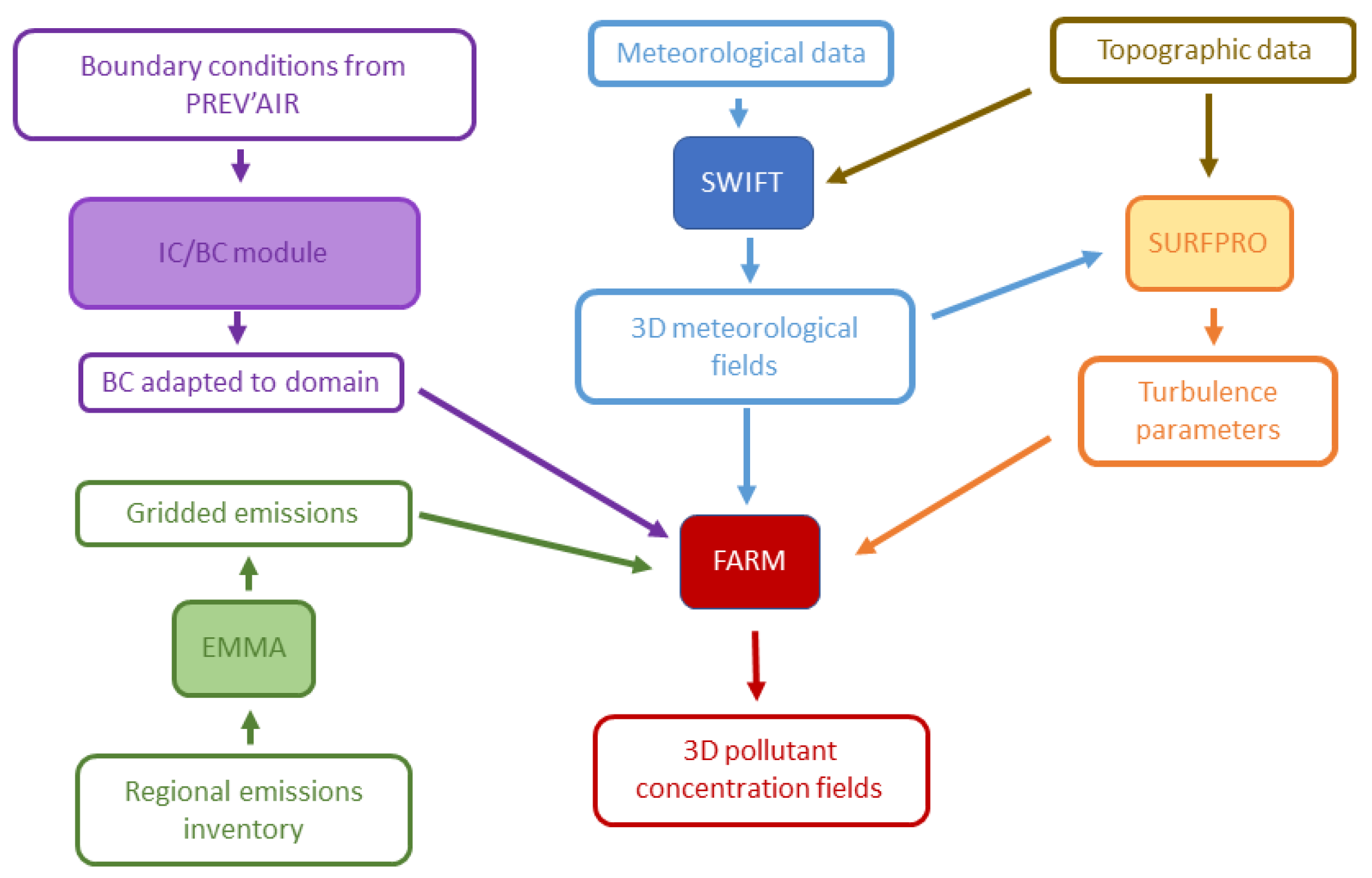
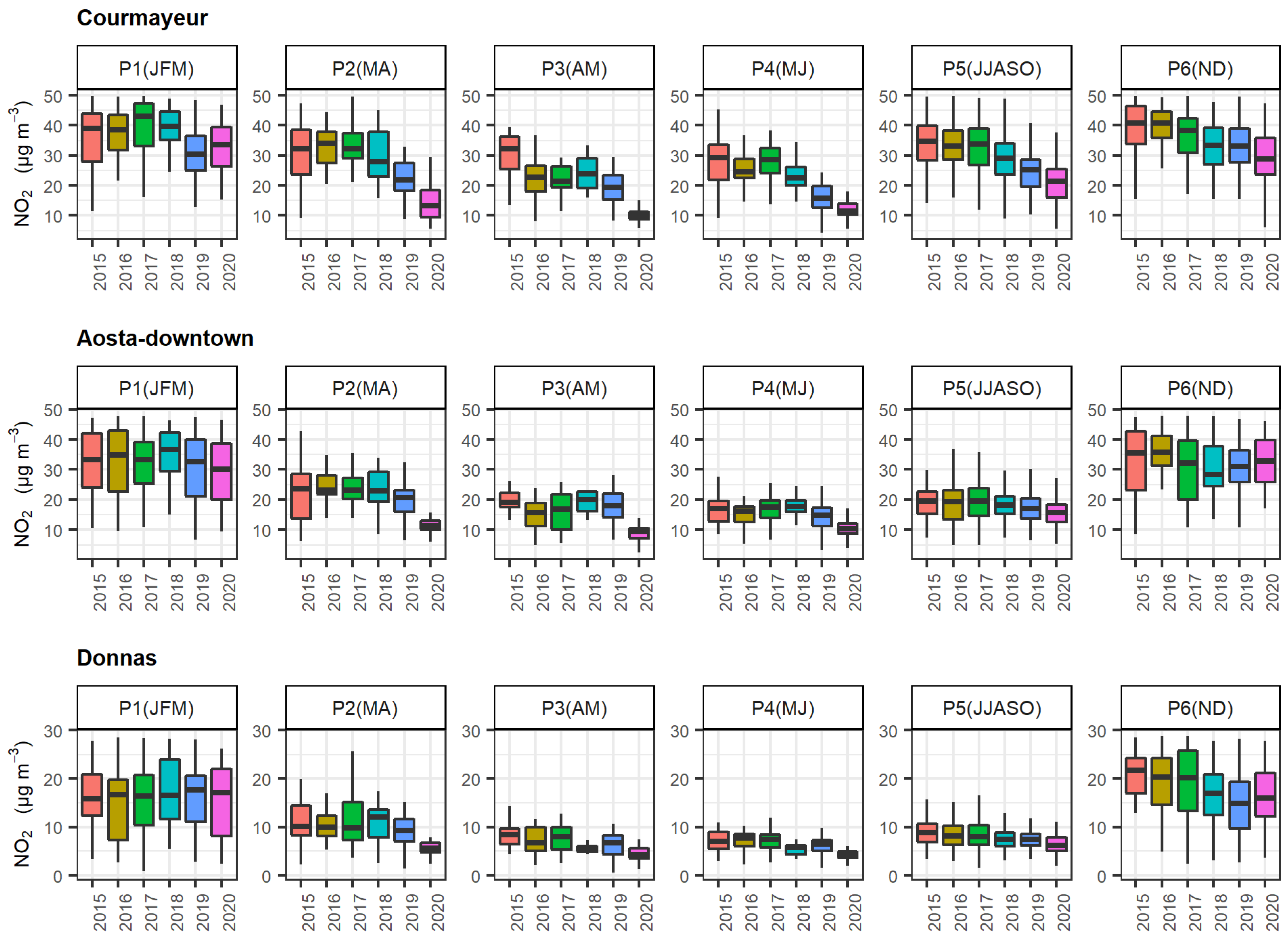
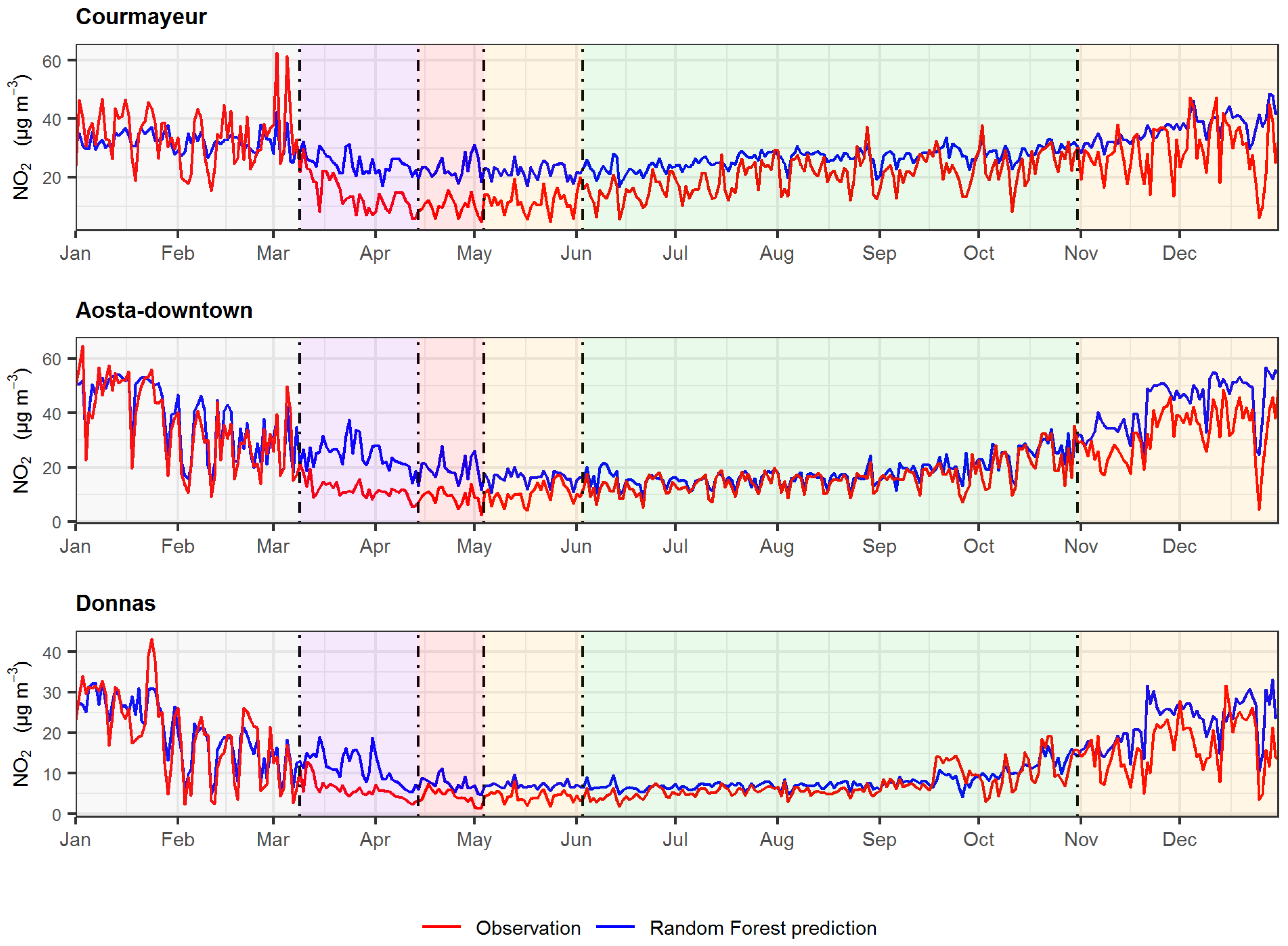
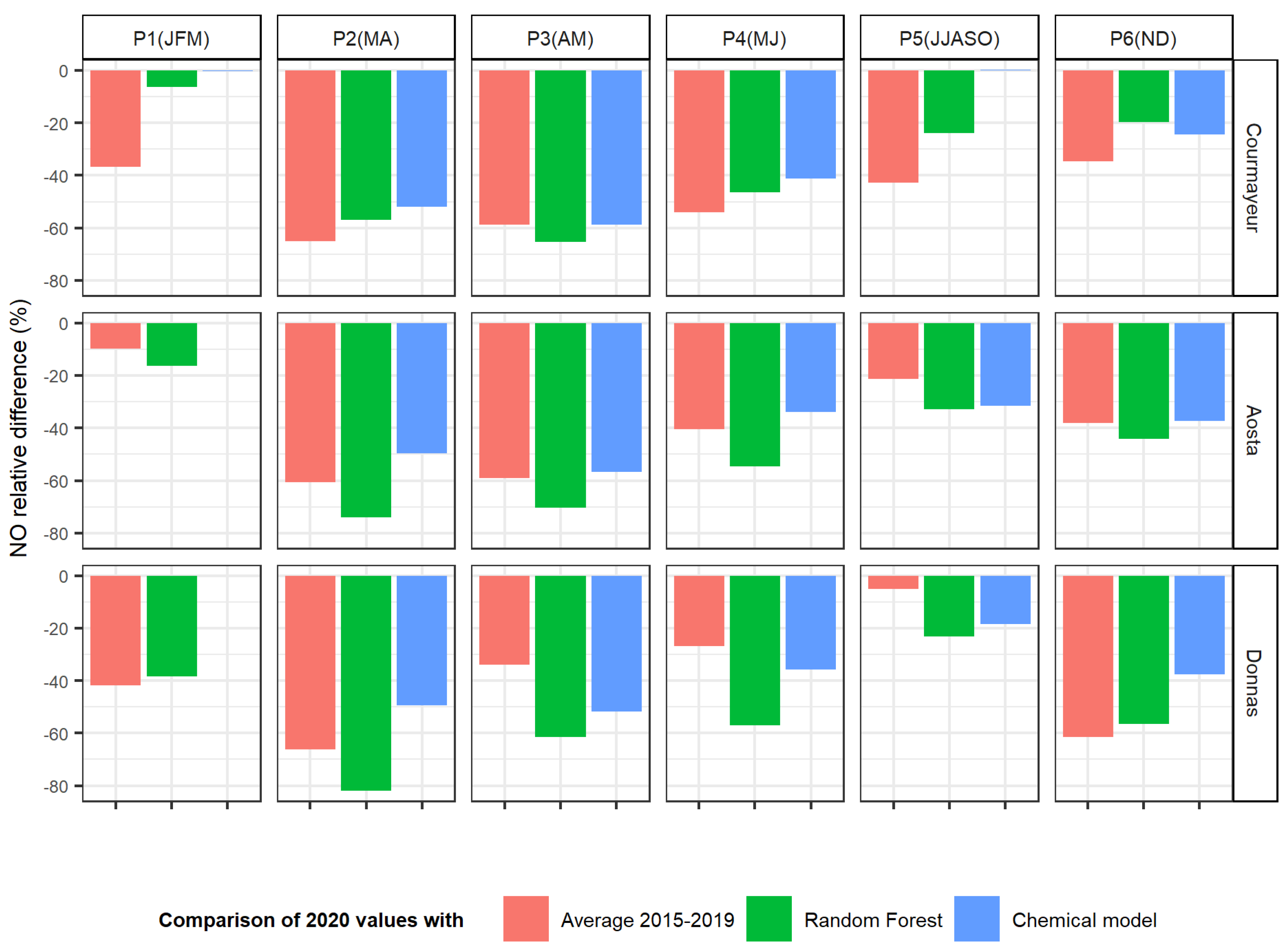
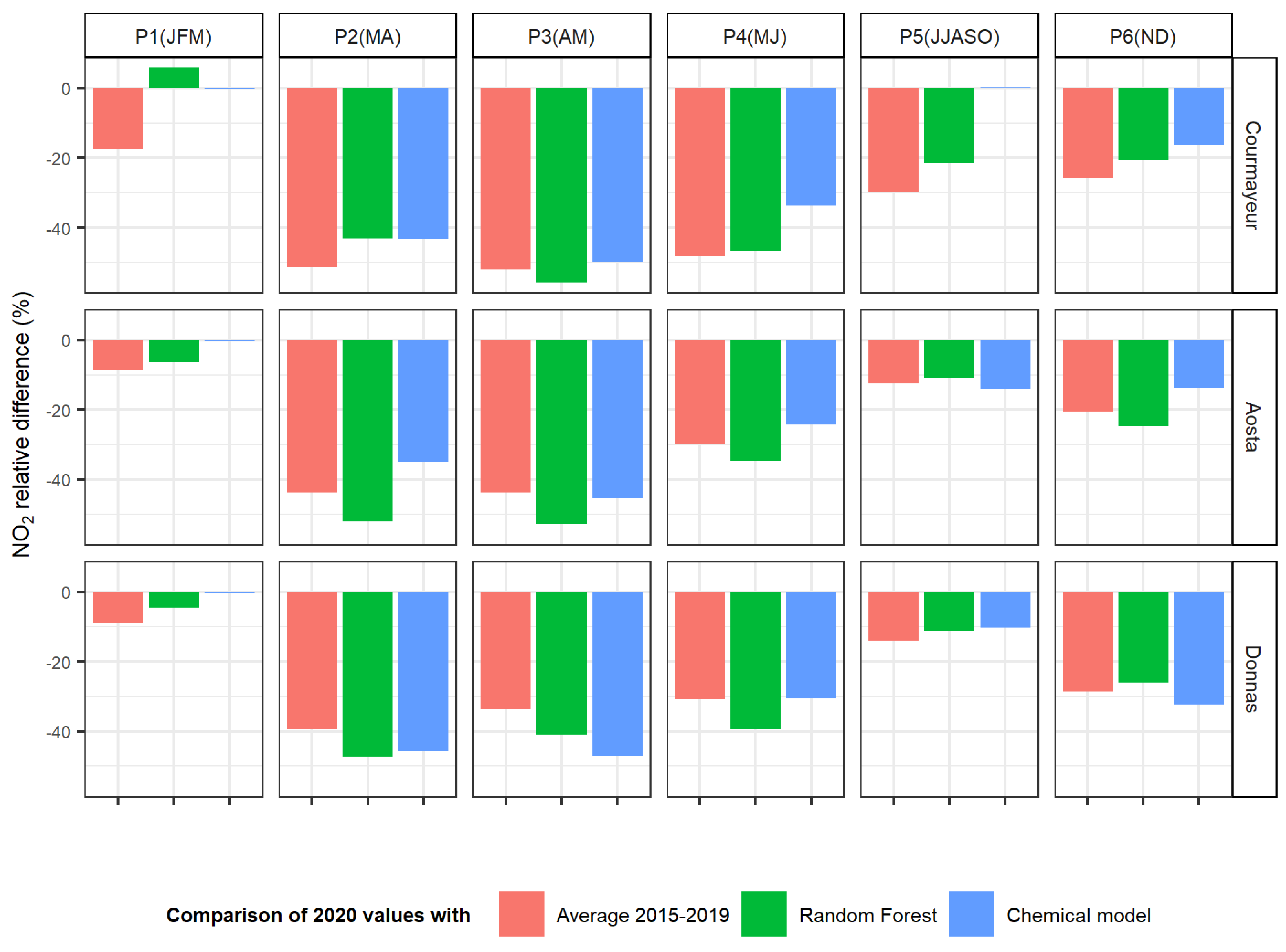
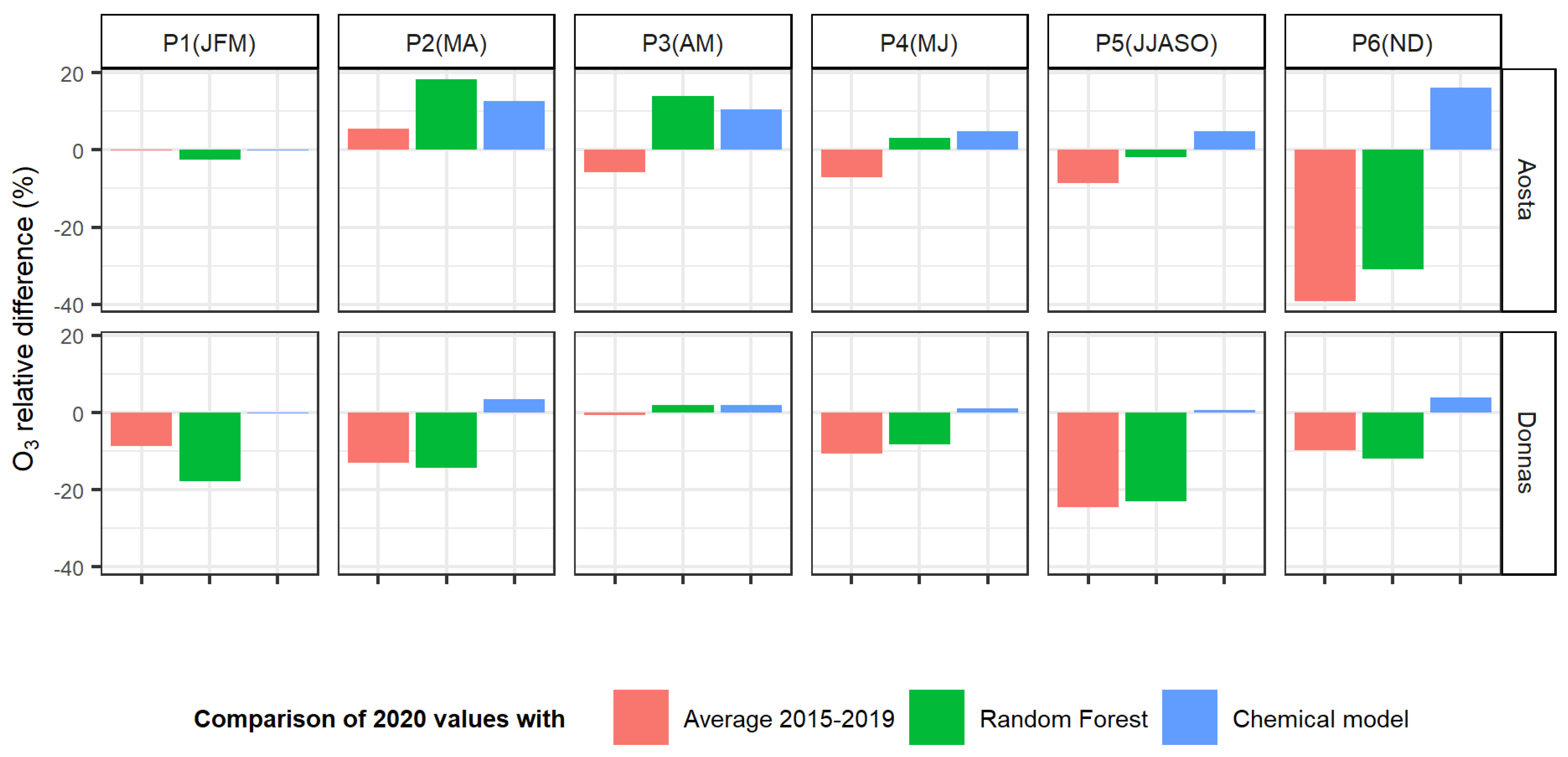
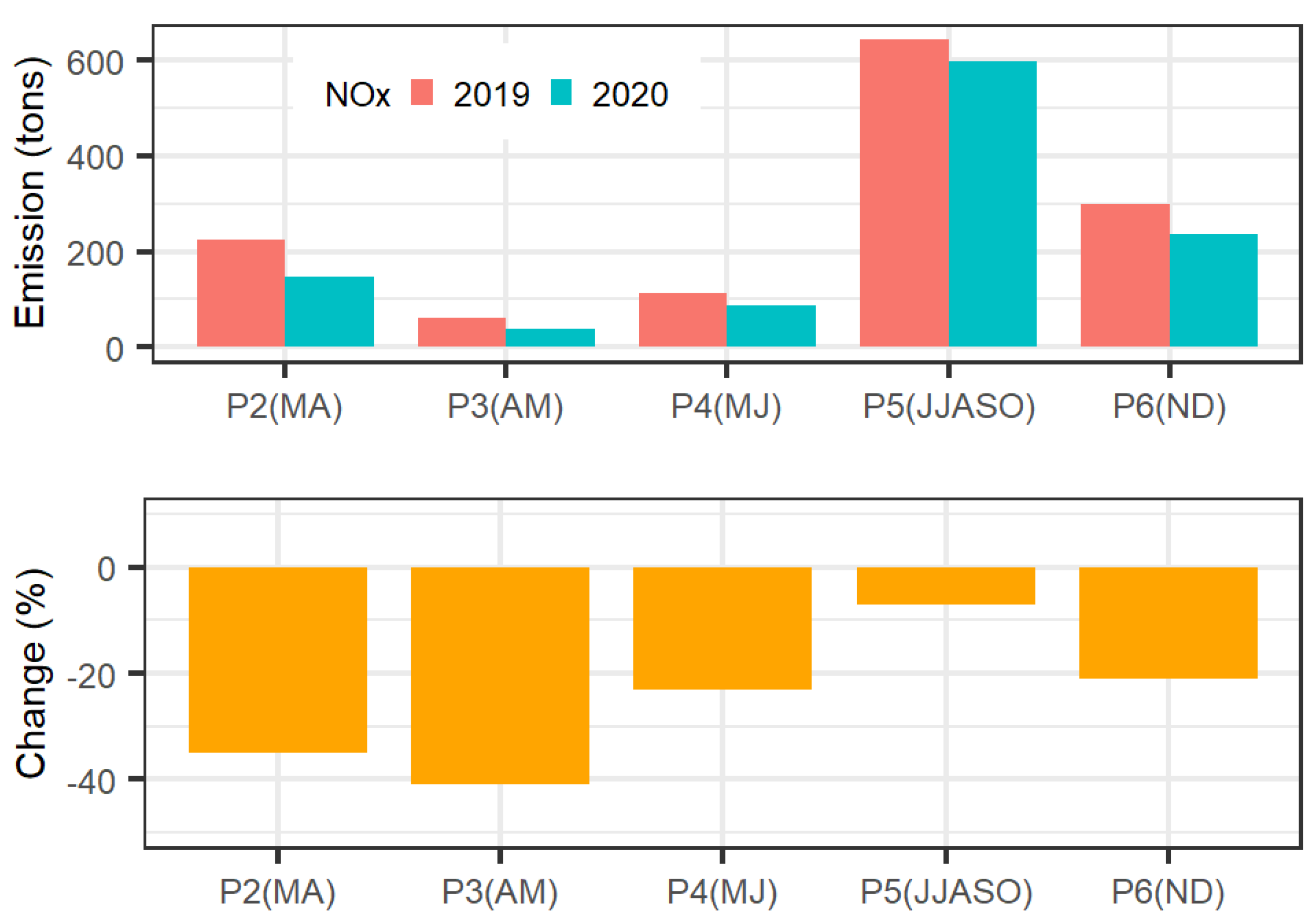
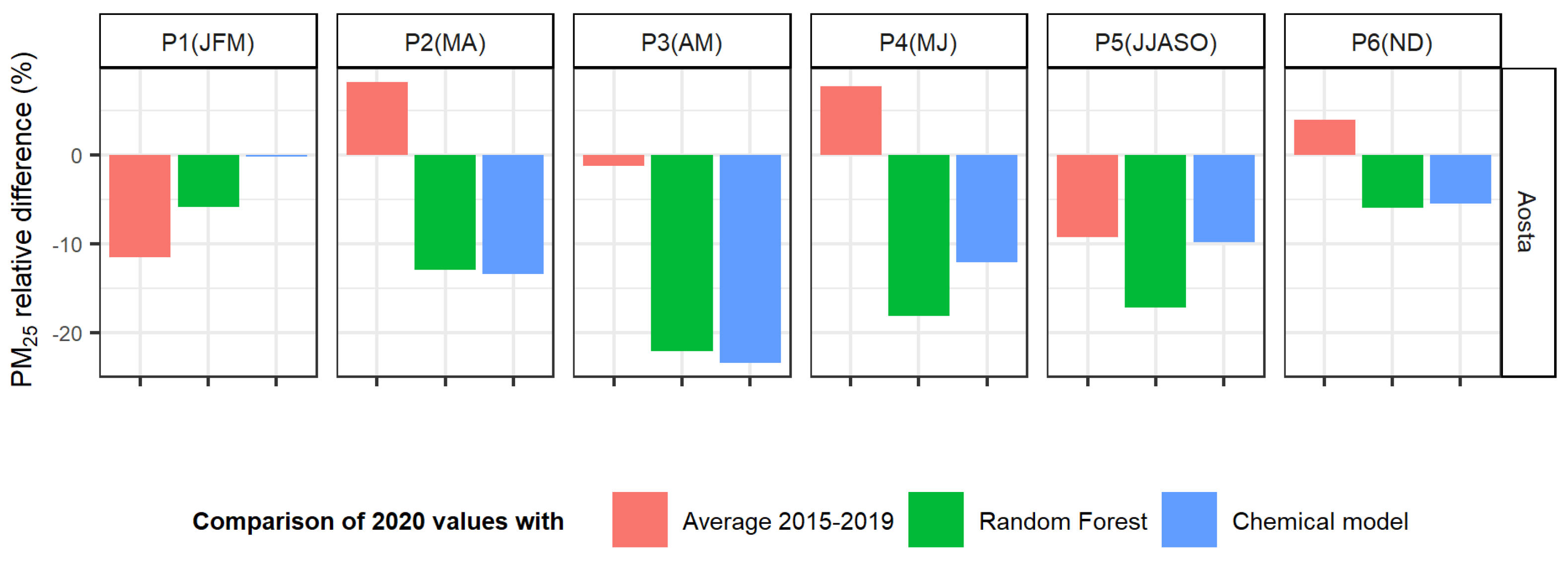
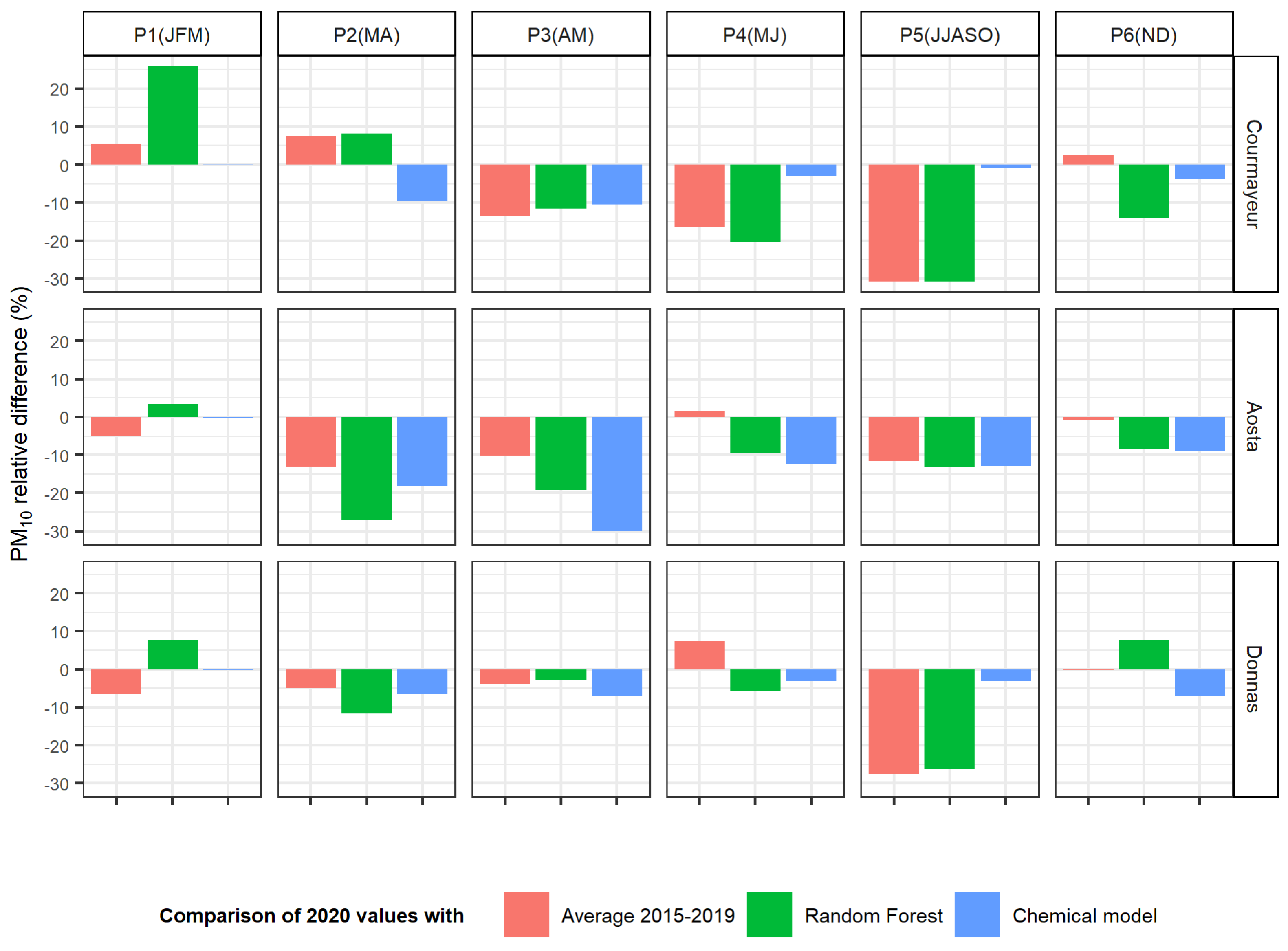
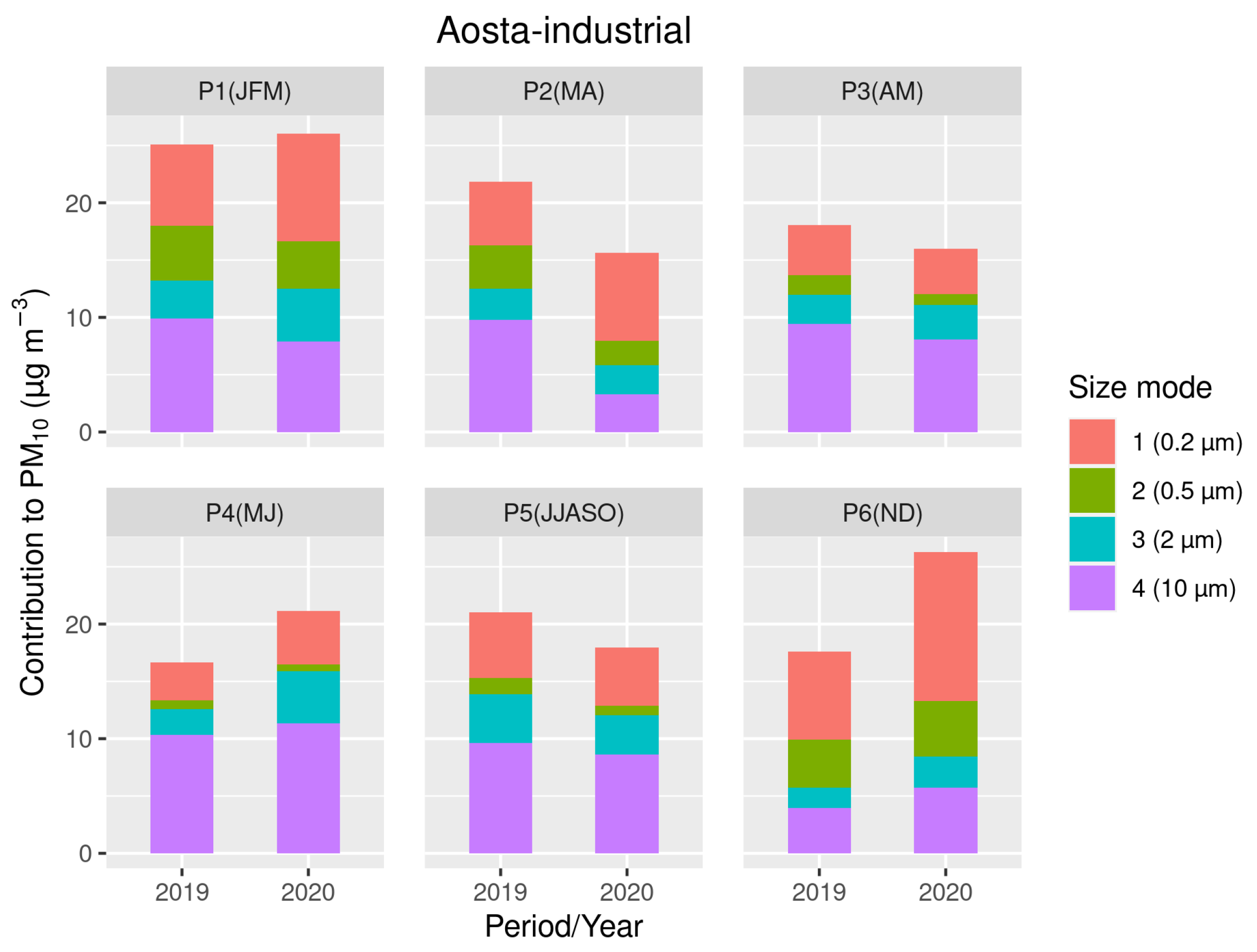

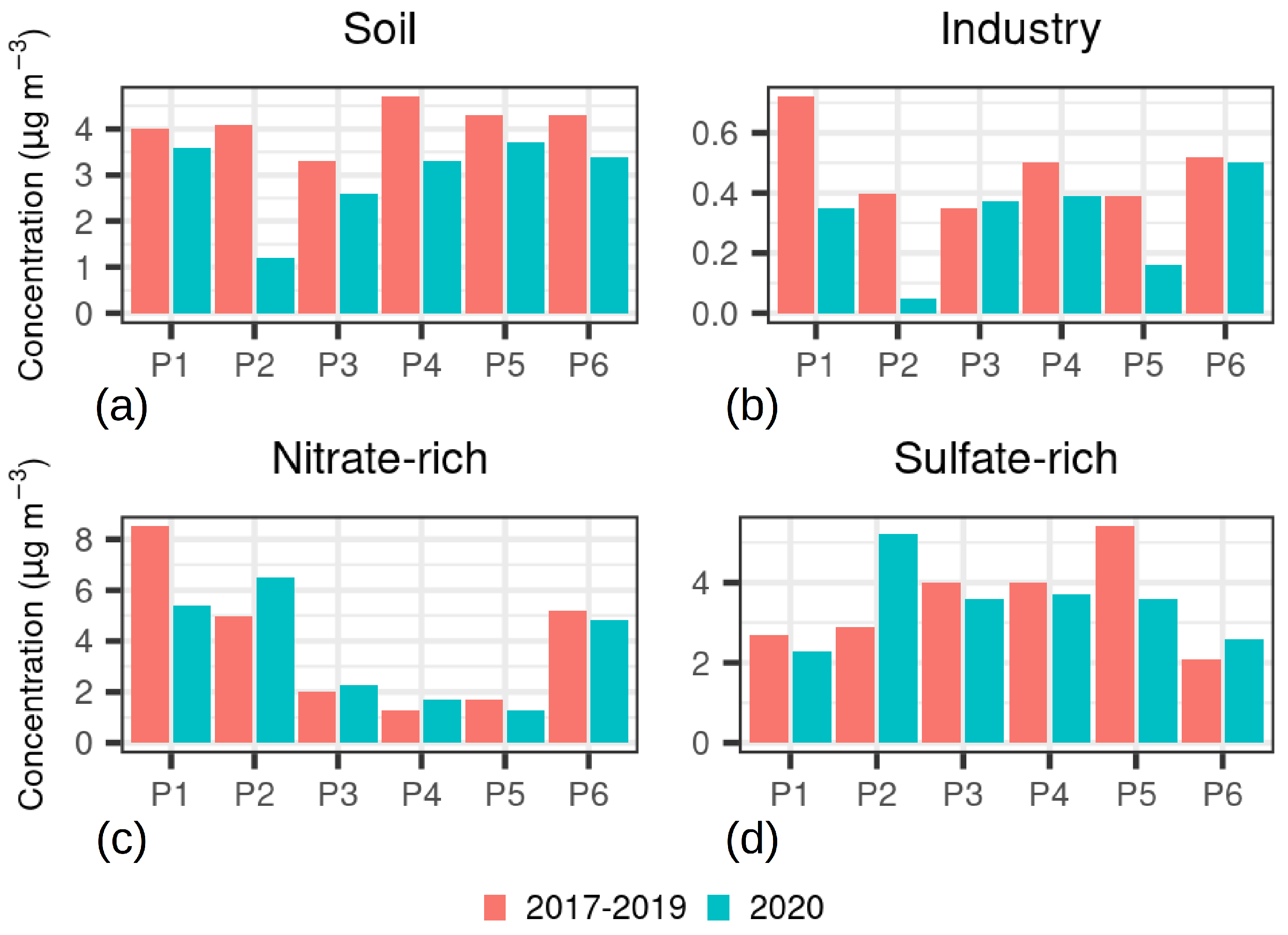
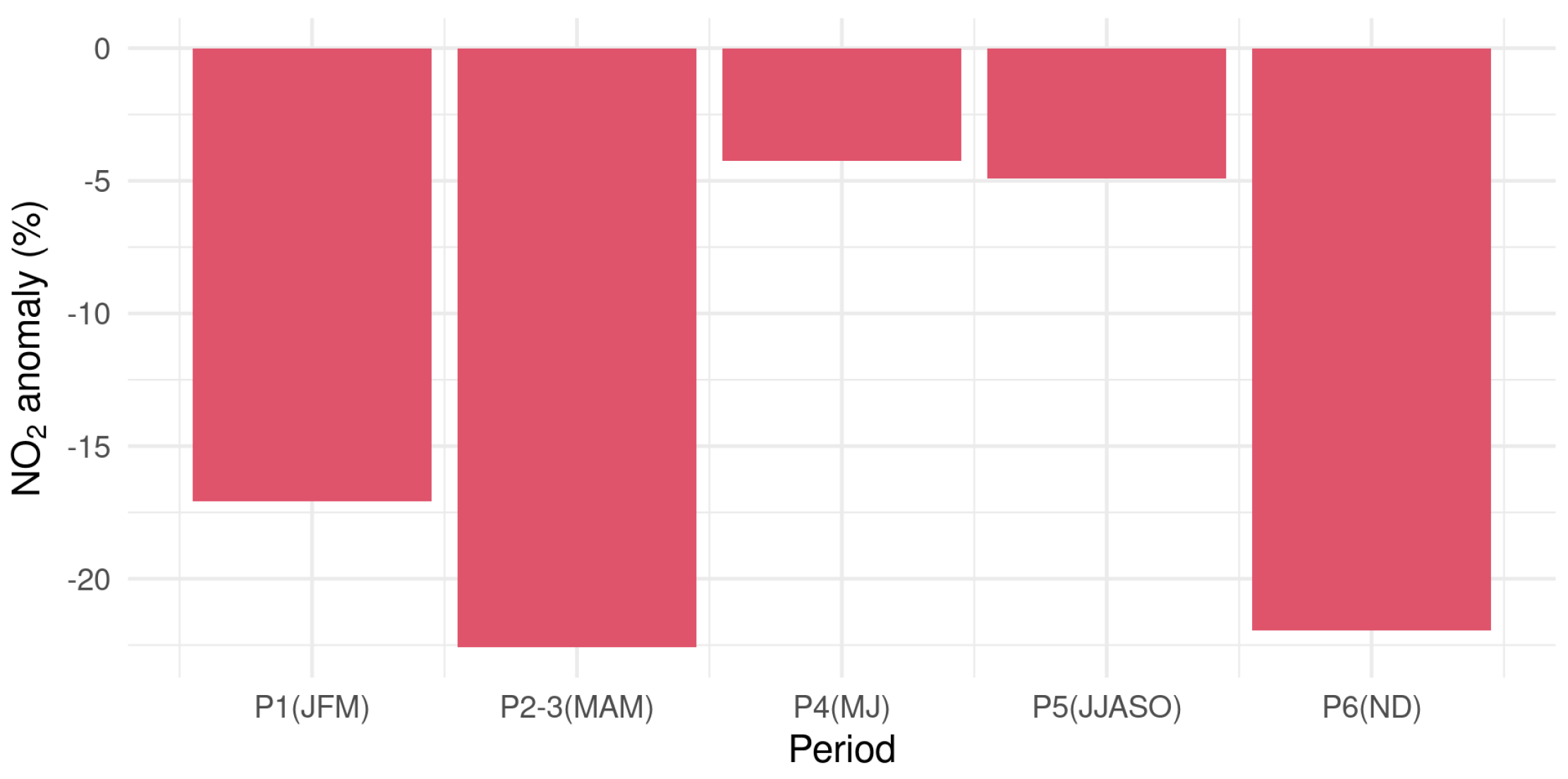

| Station | Measured Quantity | Instruments | Data Availability (Used) |
|---|---|---|---|
| Courmayeur Rural traffic 1325 m a.s.l. 45.82 N, 6.96 E | NO PM and PM hourly concentration and size distribution PM hourly concentration Standard meteorological variables | API200E Teledyne Fidas200E Palas TEOM1400A Various | 2004–now (2015–2020) 2018–now a (2018–2020) 2007–2018 (2015–2018) 2007–now (2015–2020) |
| Aosta–downtown Urban background 580 m a.s.l 45.73 N, 7.32 E | NO O PM and PM daily concentration PM and PM hourly concentration and size distribution Water-soluble anion-cation daily concentration EC/OC on PM samples Levoglucosan on PM samples Metals on PM samples Light absorption by particles Standard meteorological variables | APNA370 Horiba API400E Teledyne SM200 Opsis Fidas200E Palas Dionex ion chromatography system Sunset thermo-optical analyser Trace1300 Thermo Scientific Varian820-MS Aethalometer AE33 Magee Sci. Various | 2010–now (2015–2020) 2004–now (2015–2020) 2012–now b (2015–2020) September 2019–now (2020) 2017–now (2017–2020) 2017–now c (2017–2020) 2018–now c (2018–2020) 2000–now d (2015–2020) 2020–now (2020) 1995–now (2015–2020) |
| Aosta–industrial Industrial 570 m a.s.l 45.73 N, 7.32 E | NO PM daily concentration PM and PM hourly concentration and size distribution Metals on PM samples | APNA370 Horiba SM200 Opsis Fidas200E Palas Varian820-MS | 2018–now (not used here) 2012–now (not used here) 2019–now (2019–2020) 2012–now (2015–2020) |
| Aosta–Saint-Christophe Semi-rural 560 m a.s.l 45.74 N, 7.35 E | NO VCD Column aerosol properties Aerosol vertical profile PM and PM hourly concentration and size distribution | MkIV Brewer POM-02 Prede CHM15k-Nimbus Lufft Fidas200E Palas | 2007–now e (2015–2020) 2012–now f (2015–2020) April 2015–now (2016–2020) June 2017–February 2019 (June 2017–February 2019) |
| Donnas Rural background 341 m a.s.l. 45.60 N, 7.77 E | NO O PM daily concentration Standard meteorological variables | API200E Teledyne API400E Teledyne SM200 Opsis Various | 2006–now (2015–2020) 1995–now (2015–2020) 2011–now (2015–2020) 1996–now (2015–2020) |
| Short Name | Key Dates (dd/mm/yyyy) | COVID-19 Restrictions |
|---|---|---|
| P1(JFM) | 1 January 2020–8 March 2020 | Pre-lockdown, business-as-usual phase |
| P2(MA) | 9 March 2020–13 April 2020 | Strict lockdown, stay-at-home policy, and steel mill closed |
| P3(AM) | 14 April 2020–4 May 2020 | Confinement measures continue, steel mill reopens |
| P4(MJ) | 5 May 2020–3 June 2020 | Progressive lockdown easing, justified movements within the region allowed |
| P5(JJASO) | 4 June 2020–31 October 2020 | Further relaxation, travels between regions allowed, schools open in September |
| P6(ND) | 1 November 2020–31 December 2020 | Schools partially close, ban on travels between regions |
| Site | Modelled Air Pollutants | Meteorological Variables (Same for All Stations) | Temporal Variables (Same for All Stations) |
|---|---|---|---|
| Courmayeur Aosta–downtown Donnas | NO, NO, PM NO, NO, O, PM, PM NO, NO, O, PM | Air temperature, wind speed and direction, relative humidity, global solar radiation, atmospheric pressure, daily precipitation amount | Julian day, day of week, date (Unix timestamp) |
| Station | NO (%) | NO (%) | O (%) | PM (%) | PM (%) |
|---|---|---|---|---|---|
| Donnas | 88.9 | 16.6 | 0.4 | – | 8.2 |
| Aosta–downtown | 51.5 | 17.7 | −11.3 | 25.1 | 20.2 |
| Courmayeur | −17.8 | −13.5 | – | – | −2.7 |
Publisher’s Note: MDPI stays neutral with regard to jurisdictional claims in published maps and institutional affiliations. |
© 2021 by the authors. Licensee MDPI, Basel, Switzerland. This article is an open access article distributed under the terms and conditions of the Creative Commons Attribution (CC BY) license (https://creativecommons.org/licenses/by/4.0/).
Share and Cite
Diémoz, H.; Magri, T.; Pession, G.; Tarricone, C.; Tombolato, I.K.F.; Fasano, G.; Zublena, M. Air Quality in the Italian Northwestern Alps during Year 2020: Assessment of the COVID-19 «Lockdown Effect» from Multi-Technique Observations and Models. Atmosphere 2021, 12, 1006. https://doi.org/10.3390/atmos12081006
Diémoz H, Magri T, Pession G, Tarricone C, Tombolato IKF, Fasano G, Zublena M. Air Quality in the Italian Northwestern Alps during Year 2020: Assessment of the COVID-19 «Lockdown Effect» from Multi-Technique Observations and Models. Atmosphere. 2021; 12(8):1006. https://doi.org/10.3390/atmos12081006
Chicago/Turabian StyleDiémoz, Henri, Tiziana Magri, Giordano Pession, Claudia Tarricone, Ivan Karl Friedrich Tombolato, Gabriele Fasano, and Manuela Zublena. 2021. "Air Quality in the Italian Northwestern Alps during Year 2020: Assessment of the COVID-19 «Lockdown Effect» from Multi-Technique Observations and Models" Atmosphere 12, no. 8: 1006. https://doi.org/10.3390/atmos12081006
APA StyleDiémoz, H., Magri, T., Pession, G., Tarricone, C., Tombolato, I. K. F., Fasano, G., & Zublena, M. (2021). Air Quality in the Italian Northwestern Alps during Year 2020: Assessment of the COVID-19 «Lockdown Effect» from Multi-Technique Observations and Models. Atmosphere, 12(8), 1006. https://doi.org/10.3390/atmos12081006






